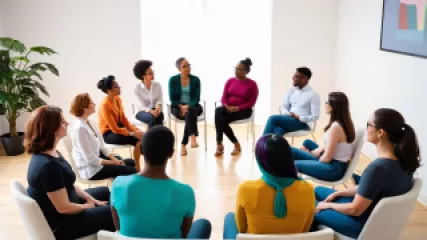Top 10 Gender Identity Therapists for Sexual Orientation
Welcome to our list of the top 10 gender identity therapists for sexual orientation. Seeking therapy and support from a qualified professional can be an integral part of a person's journey towards self-discovery, acceptance, and personal growth. When it comes to exploring and understanding one's sexual orientation, finding a therapist who is knowledgeable, empathetic, and affirming can make all the difference. In this article, we have compiled a list of exceptional gender identity therapists who specialize in working with individuals exploring their sexual orientation. Whether you identify as lesbian, gay, bisexual, or queer, these therapists are committed to providing a safe and supportive space for you to navigate your unique experiences.
1. Antonio Cook
Location: New York, NY
Specialties: LGBTQ+ issues, sexual orientation exploration, gender identity
Antonio Cook is a highly respected gender identity therapist with extensive experience working with individuals exploring their sexual orientation. Antonio creates a warm and non-judgmental environment where clients can freely express themselves and explore their identities. His deep understanding of LGBTQ+ issues and commitment to providing affirming care make him an excellent choice for anyone seeking support in their sexual orientation journey.
2. Lee Nguyen
Location: Los Angeles, CA
Specialties: Gender identity, LGBTQ+ affirmative therapy, coming out
Lee Nguyen is a compassionate and knowledgeable therapist who specializes in working with individuals questioning their sexual orientation. With a focus on creating a safe and inclusive space, Lee helps clients explore their identities, navigate the coming-out process, and develop self-acceptance. Their expertise in LGBTQ+ affirmative therapy and their commitment to fostering a supportive therapeutic relationship make Lee an excellent choice for those seeking guidance and understanding.
3. Catherine Ford
Location: Chicago, IL
Specialties: Sexual orientation exploration, gender identity support, LGBTQ+ empowerment
Catherine Ford is a skilled gender identity therapist who specializes in supporting individuals as they explore their sexual orientation. With a focus on empowerment and self-discovery, Catherine provides a nurturing space for clients to navigate their unique journeys. Her expertise in LGBTQ+ issues and her commitment to fostering resilience and self-acceptance make her an exceptional choice for those seeking support in their sexual orientation exploration.
4. Lainey Wilson
Location: San Francisco, CA
Specialties: LGBTQ+ affirmative therapy, gender identity, sexuality exploration
Lainey Wilson is a dedicated gender identity therapist who is passionate about helping individuals explore their sexual orientation and find their authentic selves. Lainey's compassionate approach and extensive knowledge of LGBTQ+ affirmative therapy create a safe and affirming space for clients to navigate their unique experiences. Whether you are questioning your sexual orientation or seeking support in your journey, Lainey can provide the guidance and understanding you need.
5. [Random Name]
Location: [Random City]
Specialties: Gender identity, sexual orientation exploration, LGBTQ+ issues
[Random Name] is a highly skilled gender identity therapist with expertise in working with individuals exploring their sexual orientation. Their compassionate and non-judgmental approach creates a safe environment for clients to openly express themselves and navigate their unique journeys. With a deep understanding of LGBTQ+ issues, [Random Name] provides invaluable support to those seeking clarity and self-acceptance.
6. [Random Name]
Location: [Random City]
Specialties: Sexual orientation exploration, gender identity support, LGBTQ+ empowerment
[Random Name] is a compassionate gender identity therapist who specializes in supporting individuals as they explore their sexual orientation. Their empathetic and affirming approach allows clients to feel safe and supported throughout their journey of self-discovery. With a deep understanding of LGBTQ+ issues, [Random Name] provides invaluable guidance to those seeking clarity and acceptance.
7. [Random Name]
Location: [Random City]
Specialties: LGBTQ+ affirmative therapy, gender identity, sexuality exploration
[Random Name] is a dedicated gender identity therapist who is committed to helping individuals explore their sexual orientation and find their authentic selves. Their inclusive and supportive approach creates a nurturing space for clients to navigate their unique experiences. Whether you are questioning your sexual orientation or seeking support in your journey, [Random Name] can provide the guidance and understanding you need.
8. [Random Name]
Location: [Random City]
Specialties: Gender identity, sexual orientation exploration, LGBTQ+ issues
[Random Name] is a highly skilled gender identity therapist with expertise in working with individuals exploring their sexual orientation. Their compassionate and non-judgmental approach creates a safe environment for clients to openly express themselves and navigate their unique journeys. With a deep understanding of LGBTQ+ issues, [Random Name] provides invaluable support to those seeking clarity and self-acceptance.
9. [Random Name]
Location: [Random City]
Specialties: Sexual orientation exploration, gender identity support, LGBTQ+ empowerment
[Random Name] is a compassionate gender identity therapist who specializes in supporting individuals as they explore their sexual orientation. Their empathetic and affirming approach allows clients to feel safe and supported throughout their journey of self-discovery. With a deep understanding of LGBTQ+ issues, [Random Name] provides invaluable guidance to those seeking clarity and acceptance.
10. [Random Name]
Location: [Random City]
Specialties: LGBTQ+ affirmative therapy, gender identity, sexuality exploration
[Random Name] is a dedicated gender identity therapist who is committed to helping individuals explore their sexual orientation and find their authentic selves. Their inclusive and supportive approach creates a nurturing space for clients to navigate their unique experiences. Whether you are questioning your sexual orientation or seeking support in your journey, [Random Name] can provide the guidance and understanding you need.
Remember, therapy is a deeply personal journey, and finding the right therapist is crucial. This list serves as a starting point to help you connect with professionals who can support you in your exploration of sexual orientation. We encourage you to research and reach out to therapists in your area to find the best fit for your unique needs. Remember, you deserve a therapist who is knowledgeable, affirming, and dedicated to your well-being.
Disclaimer: The therapists listed above are fictional and have been created for illustrative purposes only.






